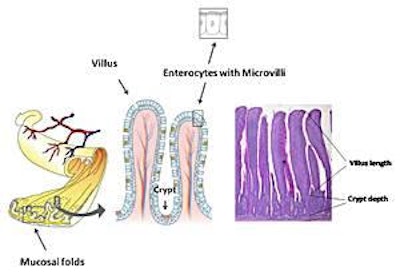
The proper functioning of a newborn chick’s gastrointestinal tract is essential for growth and performance, so achieving optimal intestinal development and the functional capacity of young birds should never be overlooked.
The intestine of hatchlings increases in weight as much as five times more rapidly than most of its other organs or body mass. This fast development of the intestinal mucosa with villi, crypts and enterocytes is essential for absorption of nutrients and subsequent performance.
The gastrointestinal tract can adapt and react morphologically to external factors, such as changes in diet. An increase in the mucosal surface area, for example, could result in an improved capacity to absorb available nutrients.
To understand how to best influence the development, maintenance and functioning of the gastrointestinal tract, it is import to understand how it is structured.
Rapid change
The development of the gastrointestinal tract begins soon after epithelial cells form a tube in the embryo. The intestine – including the external muscular layers and the villi – grow quickly and the structure of the small intestine changes rapidly. Immediately after hatching, further rapid changes with significant morphological development of the small intestine occur. The gastrointestinal tract must be ready to absorb nutrients to sustain the bird as well as to provide a barrier to external challenges.
Structure of the small intestine
The inner surface of the small intestine is not flat, but is thrown into circular mucosal folds that increase its surface area and aid in mixing the ingesta.
The mucosa form intestinal villi – tiny, finger-like projections that increase the surface and absorptive area of the intestinal wall, providing efficient absorption of nutrients from the lumen. Crypts are moat-like invaginations of the epithelium around the villi. Toward the base of the crypts are stem cells, which continually divide and provide the source of all the epithelial cells in the crypts and on the villi.
Additives influence villi development
While performance parameters may be the most common way of evaluating feeding trials, they can be evaluated through histological examination of the gastrointestinal tract, as it is well known that many substances can affect the development of intestinal villi.
The gastrointestinal tract can adapt and react morphologically to factors such as dietary changes, for example to the addition of probiotics and prebiotics in the diet, and investigations to determine changes can reveal useful information on intestinal function.
Enterocyte enzymatic activity and structure are two of the most important features of the intestinal mucosal physiology, and it has been reported that the intestine can change its surface by growing in length, and/or by increasing the height of its villi.
By growing in length, and/or by increasing or decreasing the height of the villi and microvilli, it is possible to change the effective surface area. Fusion and shortening of the villus, on the other hand, can lead to a loss of surface area for the digestion and absorption of nutrients and consequently, lower performance.
Increasing the villus height would suggest an increased surface area capable of greater absorption of available nutrients, and enterocytes have more time to fully differentiate and to fulfill their digestive and absorptive functions.
The villus crypt is considered as the villus factory, and deeper crypts indicate fast tissue turnover to renew the villus in response to normal sloughing or inflammation resulting from pathogens or their toxins.
Because the energy required to maintain the gut accounts for some 25 percent of the total basal metabolic needs of an animal, any reduction of need for renewal of gut tissue can have a significant impact on the amount of energy available for growth and caloric conversion efficiency.
Positive influences
Several scientific studies have shown that the addition of probiotic products to broiler diets can have a positive effect on gut morphology and consequently, on performance parameters.
These histomorphological changes are represented by elongated villi and a higher villi/crypt ratio, which indicates a lower rate of enterocyte-cell migration from the crypt to the villus. When less energy is needed for renewal of the gut epithelium, more energy is available for growth.
Feeding probiotic growth additives has been shown to increase the villus surface area, which consequently may lead to higher nutrient absorption. It can be speculated that increased integrity of the gastrointestinal tract associated with a greater surface area of the villi results in improved production results. Probiotic feed additives could reduce both damage to enterocytes and the need for cell renewal in the gut, contributing to an increase in overall productivity.

















